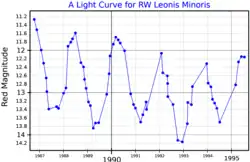CIT 6
CIT 6 is a carbon star in the constellation Leo Minor. It is a semiregular variable star, with a period of about 628 days, and has been given the variable star designation RW Leonis Minoris.[1] It is perhaps the second most studied carbon star, after CW Leonis.[8] CIT 6 was discovered in 1966 by a group at the California Institute of Technology (which is why it is named CIT 6) who found it using the same 62-inch infrared telescope on Mount Wilson that was used to produce the Two-Micron Sky Survey.[9] It is the second brightest carbon star in the near-infrared, after CW Leonis (which is much closer to us).[1]
| Observation data Epoch J2000 Equinox J2000 | |
|---|---|
| Constellation | Leo Minor |
| Right ascension | 10h 16m 02.27770s[2] |
| Declination | +30° 34′ 19.0451″[2] |
| Apparent magnitude (V) | 12.8 - 16.5[3] |
| Characteristics | |
| Spectral type | C4,3[4] |
| Variable type | SRa[3] |
| Astrometry | |
| Radial velocity (Rv) | −1.5 (LSR)[5] km/s |
| Proper motion (μ) | RA: −18.803[2] mas/yr Dec.: 8.940[2] mas/yr |
| Parallax (π) | 3.1833 ± 0.2413 mas[2] |
| Distance | 1,020 ± 80 ly (310 ± 20 pc) |
| Details | |
| primary | |
| Mass | <1[6] M☉ |
| Radius | 575[7] R☉ |
| Luminosity | 10,000[7] L☉ |
| Temperature | 2,445[7] K |
| companion | |
| Mass | 1-2[6] M☉ |
| Other designations | |
| Database references | |
| SIMBAD | data |
CIT 6 is believed to be a highly evolved star, in transition from the AGB phase to the protoplanetary nebula phase.[6] It is surrounded by a thick circumstellar envelope (CSE) of dust and molecular gas.[10][11] Absorption and re-radiation of the starlight by the dust makes the object far brighter in the infrared than it is in visible light.[12] The molecular gas was first seen by Knapp and Morris in 1985, who detected a CO emission line.[13] Later studies of millimeter-wave radio emission have detected over 20 different molecular species in the CSE. There include CN, HCN, HC3N, HC5N, HC7N, SiS, SiO, SiC2, C4H and CH3CN.[11][14]
HST images show that the dust component of the innermost region of CIT 6's CSE has developed the bipolar shape that is frequently seen in protoplanetary nebulae.[12] High spatial resolution interferometric measurements show that the CO emission lines arise from a spiral structure. The spiral structure of the molecular gas outflow, combined with the bipolar shape seen by the HST, strongly suggests that CIT 6's AGB star has a binary companion.[6]
Although it's invisible to the human eye, the CSE of CIT 6 covers a region of our night sky roughly 1/4 of the size of the full moon. The outermost edge of the CSE was seen by the GALEX satellite. It appears as two long arcs of emission (of ultraviolet light) 15 and 18 arc minutes in diameter, caused by the stellar wind colliding with the interstellar medium. The large size of the CSE indicates that CIT 6 has been losing mass at a high rate for at least 93,000 years.[8]
See also
References
- Alksnis, A. (January 1995). "Photographic Photometry of the Carbon Star RW LMi (CIT6) during 1989--1995". Baltic Astronomy. 4: 79–87. Bibcode:1995BaltA...4...79A. doi:10.1515/astro-1995-0107. S2CID 117340209.
- Brown, A. G. A.; et al. (Gaia collaboration) (2021). "Gaia Early Data Release 3: Summary of the contents and survey properties". Astronomy & Astrophysics. 649: A1. arXiv:2012.01533. Bibcode:2021A&A...649A...1G. doi:10.1051/0004-6361/202039657. S2CID 227254300. (Erratum: doi:10.1051/0004-6361/202039657e). Gaia EDR3 record for this source at VizieR.
- "RW LMi". The International Variable Star Index. AAVSO. Retrieved 1 June 2022.
- Cohen, M. (March 1979). "Circumstellar envelopes and the evolution of carbon stars". Monthly Notices of the Royal Astronomical Society. 186 (4): 837–852. Bibcode:1979MNRAS.186..837C. doi:10.1093/mnras/186.4.837.
- Olofsson, H.; Eriksson, K.; Gustafsson, B.; Carlstrom, U. (July 1993). "A Study of Circumstellar Envelopes around Bright Carbon Stars. I. Structure, Kinematics, and Mass-Loss Rate". Astrophysical Journal Supplement. 87: 267. Bibcode:1993ApJS...87..267O. doi:10.1086/191804.
- Kim, Hyosun; Liu, Sheng-Yuan; Hirano, Naomi; Zhao-Geisler, Ronny; Trejo, Alfonso; Yen, Hsi-Wei; Taam, Ronald E.; Kemper, Francisca; Kim, Jongsoo; Byun, Do-Young; Liu, Tie (November 2015). "High-resolution CO Observation of the Carbon Star CIT 6 Revealing the Spiral Structure and a Nascent Bipolar Outflow". The Astrophysical Journal. 814 (1): 61. arXiv:1510.03916. Bibcode:2015ApJ...814...61K. doi:10.1088/0004-637X/814/1/61. S2CID 119096472.
- Milam, S. N.; Woolf, N. J.; Ziurys, L. M. (2009). "Circumstellar 12C/13C Isotope Ratios from Millimeter Observations of CN and CO: Mixing in Carbon- and Oxygen-Rich Stars". The Astrophysical Journal. 690 (1): 837. Bibcode:2009ApJ...690..837M. doi:10.1088/0004-637X/690/1/837. S2CID 21694789.
- Sahai, Raghvendra; Mack-Crane, Galen P. (October 2014). "The Astrosphere of the Asymptotic Giant Branch Star CIT 6". The Astronomical Journal. 148 (4): 74. arXiv:1408.1050. Bibcode:2014AJ....148...74S. doi:10.1088/0004-6256/148/4/74. S2CID 119286571.
- Ulrich, B. T.; Neugebauer, G.; McCammon, D.; Leighton, R. B.; Hughes, E. E.; Becklin, E. (October 1966). "Further Observations of Extremely Cool Stars". Astrophysical Journal. 146: 288. Bibcode:1966ApJ...146..288U. doi:10.1086/148881.
- Bogdanov, M. B.; Taranova, O. G. (March 2005). "Infrared photometry of the carbon star RW LMi and an axisymmetric model for its dust envelope". Astronomy Reports. 49 (3): 226–231. Bibcode:2005ARep...49..226B. doi:10.1134/1.1882780. S2CID 120106060.
- Zhang, Yong; Kwok, Sun; Dinh-V-Trung (February 2009). "A Molecular Line Survey of the Highly Evolved Carbon Star CIT 6". The Astrophysical Journal. 691 (2): 1660–1677. arXiv:0808.3226. Bibcode:2009ApJ...691.1660Z. doi:10.1088/0004-637X/691/2/1660. hdl:10722/59598. S2CID 16133227.
- Schmidt, Gary D.; Hines, Dean C.; Swift, Seth (September 2002). "The Nascent Bipolar Nebula Surrounding the Carbon-rich Variable CIT 6: Transition to Axisymmetry". The Astrophysical Journal. 576 (1): 429–444. Bibcode:2002ApJ...576..429S. doi:10.1086/341623.
- Knapp, G. R.; Morris, M. (May 1985). "Mass Loss from Evolved Stars. III. Mass Loss Rates for 50 Stars from CO J = 1--0 Observations". Astrophysical Journal. 292: 640. Bibcode:1985ApJ...292..640K. doi:10.1086/163197.
- Chau, Wayne; Zhang, Yong; Nakashima, Jun-ichi; Deguchi, Shuji; Kwok, Sun (November 2012). "Molecular Line Observations of the Carbon-rich Circumstellar Envelope CIT 6 at 7 mm Wavelengths". The Astrophysical Journal. 760 (1): 66. Bibcode:2012ApJ...760...66C. doi:10.1088/0004-637X/760/1/66. S2CID 53369764.
